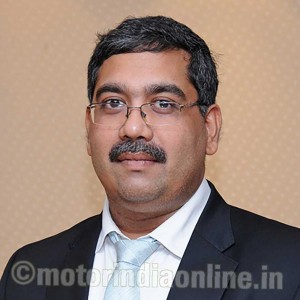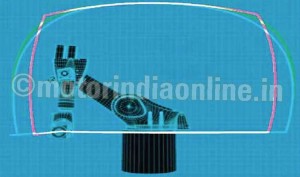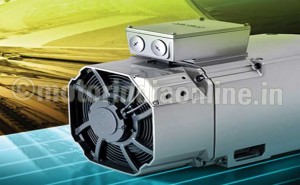Siemens Totally Integrated Automation, the right solution
By Nitin S. Nair, Chief Manager, Automotive Vertical, Siemens Ltd.
The commercial vehicle industry is considered the mirror of economic activity in a country. The CV industry in India has grown at a CAGR of 11 per cent over the last five years and is projected to grow at a CAGR of 16 per cent till 2020 and reach a volume of two million vehicles by then. This growth is expected to be driven by investments in infrastructure, road expansion, fleet development, urbanization and overall growth in the Indian economy.
The commercial vehicle sector can be broadly categorized as light commercial vehicles (LCVs) and medium & heavy commercial vehicles (M&HCVs) based on the gross vehicle weight (GVW) of the vehicle. M&HCVs can be further classified into highway & off-highway segments. LCVs are mainly used for intra city or short haul trips while M&HCVs are used for transport of heavy commodities such as steel, cement, fertilizers, etc. It should, however, be noted that the off-highway segment like buses and garbage trucks are driven by the rapid urbanization trend in India.

Globally, the CV industry is undergoing a radical transformation, wherein demand is shifting to emerging markets where the focus is on the cost per km or rather the lower total cost of ownership. In order to reduce the total cost of ownership, CV manufacturers have to optimize fuel consumption, simplify product design and improve power-to-weight ratios in their vehicles. Additionally, they also have to produce vehicles at a competitive cost to be able to sell in the emerging markets. This means that they have to optimize both the product and production of these commercial vehicles.
Stricter regulations, the increasing importance of fuel and a greater focus on corporate social responsibility is lending momentum to the global hybrid power-train market for off-highway commercial vehicles. In fact, hybridization is emerging as a key optimal-cost solution for emission compliance, as well as noise reduction.
The demands faced by the automotive industry require that innovations be provided continuously, not only in the vehicle itself but also in design, manufacturing and on the road. Siemens provides solutions and services across the entire lifecycle for both product and production of commercial vehicles.
The major challenges faced by CV manufacturers are higher productivity, increased line availability and multi-model production on the same line; improving resource efficiency, lower cost of energy for the same production; and compliance with stricter emission norms.
Increased availability
The automotive industry has traditionally played a trend-setting role in terms of improving productivity. With an hour of production time in the automotive industry costing up to $100,000, automakers still continue to concentrate their efforts on driving down the number of operating hours needed to produce a vehicle and on increasing plant availability. This can be achieved by continuous improvement in production times on the manufacturing line by reduction in all types of wastes on the line such as idle times, unnecessary material flow, storage on the manufacturing line, other non-value added work, etc.
In order to achieve this reduction in wastes, it is necessary that accurate information is available quickly at the point of decision-making on the manufacturing line. This improvement is brought about by intelligent networked automation on a manufacturing line which is dynamically interlinked with PLM & ERP systems.
The vehicle manufacturing schedule based on the incoming orders is available from the ERP system. The process & component bill of materials for various models & variants are made available from the PLM system. With these inputs, the intelligent networked automation creates a synchronized environment for seamless production of vehicles on the production line.
Material flow to the line is synchronized. Production information available to the operator is relevant to the current vehicle at his station, and quality gates have the right check parameters programmed for the incoming vehicle. Robots/machines have the right programs for the planned operation on the incoming vehicle. All this ensures optimum interlinking between all the different automation components within the production process to maximize productivity through the Siemens-developed ‘Totally Integrated Automation (TIA)’ concept.
Higher flexibility
As markets become more volatile, the nature of incoming vehicle orders change frequently in terms of models and variants. Vehicle manufacturers need an efficient and flexible assembly line which can accommodate production of different vehicle models and variants with minimum disruptions. Significant costs overrun can occur if labor scheduling, equipment usage and assembly processes need to be changed at the later stages. Therefore, it is necessary to validate product and manufacturing processes digitally to ensure production rates are achievable and are meeting all quality and dimensional metrics.
Integrated PLM solutions from Siemens allow the digital validation of all models/variants and production scenarios thus ensuring that plant equipment is utilized efficiently to support multi-product and multi-variant production. In addition, human simulation and ergonomic analysis tools can be used to make sure assembly processes are safe and efficient.
More with less
Vehicle manufacturers are looking for a sustainable approach on energy efficiency. Energy consumption is a significant environmental and cost factor in vehicle production. Added to this is the need to comply with the statutory requirements relating to energy-efficient production and reduced carbon emissions. The ISO 50001 energy management system standard sets out to define internationally applicable parameters for reducing energy costs, greenhouse gases and other environmental impacts. This is where the Siemens holistic approach of analyzing the entire value chain comes into play, starting with measurement and transparency.
The data is processed in real-time for continuous detailed analysis and targeted measures are designed to improve energy efficiency with intelligent power management hard and software like PROFINET/PROFIBUS. One example is the so-called off-peak times with little or no production. They often account for up to 30 per cent of the working day’s total energy consumption in automotive plants.
With PROFIenergy, standby-loads that are not needed can be deliberately shut down and energy consumption can be reduced by up to 80 per cent. PROFIenergy allows easy, automated switching on and off of technologically associated parts of a plant.
Siemens PLM-Software plays a critical role in global engineering with respect to standardization and process efficiency required in manufacturing processes. Already 80 per cent of the overall energy consumption during manufacturing is defined in the planning phase. Together with Totally Integrated Automation Portal software, PLM enables complete consistent planning and production processes, with most efficient use of resources. For example, up to 50 per cent energy reduction can be achieved in a robot by making movement of manufacturing robots smooth. Thanks to PLM software, robot movements during manufacturing can be simulated and harmonized in the virtual world before implementing on the real manufacturing line.
Virtual optimization of manufacturing processes during the planning phase is fundamental for early identification and optimization of energy consumption.
Another example is the press line simulation. The press movements during the manufacturing process are simulated in the digital factory and optimized to create the most energy efficient sequences with up to 20 per cent lower energy consumption compared to the traditional sequences. This, coupled with the technologically advanced controls and drives from Siemens, can further add regeneration of energy when the motors are in braking mode leading to significantly lower energy consumption for the same production throughput. The paint shop in a vehicle manufacturing plant is the biggest consumer of energy as it has the most energy intensive processes like heating and drying and also high energy consuming components like robots and large blowers.
Lifecycle simulation of the paint shop shows that for most of the components the investment cost is a small fraction of the energy cost over the lifecycle of the paint shop. This easily brings out the benefits of using the Siemens world class energy-efficient motors which significantly increase energy efficiency over standard motors and have a payback time of one to three years compared to standard motors.
Leveraging technology for compliance
The increasing scarcity of fossil fuels and the ever tighter emission norms are making the commercial vehicle industry to move towards hybrid and electric vehicles. A hybrid diesel-electric city bus, for example, consumes up to 40 per cent less diesel, has significantly lower emissions of harmful gases and has substantially lower noise compared to a diesel city bus of the same size and capacity.
Siemens is the global leader in electric motors producing more than 1.5 million units every year. It has pioneered development of special motors for hybrid and electric vehicles and offers a modular system consisting of the electric motor, power electronics and energy storage modules with high flexibility, allowing the vehicle manufacturer to configure the hybrid drive as per the individual vehicle requirements. This ensures that the internal combustion engine of the hybrid vehicle can be run at the most fuel efficient point to achieve the highest fuel efficiency and lowest emissions. The power from the internal combustion engine is stored in an onboard power bank from which the electric motor draws power to run the vehicle.
This world leading electric powertrain technology, combined with innovative concepts like wireless charging, makes Siemens solution very simple and highly efficient for vehicle manufacturers.


